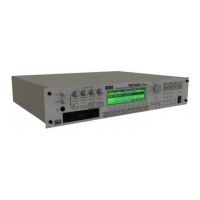32
Press the [F8] (“UTILITY”) key to access the utility
menu, and press the [F7] key to select “Grid.”
Press the [F8] (“OK”) key. The following dialog
box will appear.
Check “Grid,” set “Resolution” to , and press the
[F8] (“OK”) key. Set “ (Grid Tempo)” to 140. With
these settings, vertical dotted lines will be dis-
played at 140 BPM quarter note intervals.
Set “E (End).”
When “Lp (Loop)” is On, the dotted vertical “Grid”
lines will start at “LpS (Loop Start).” If you want to
set “End” at the end of one 4/4 measure, the fourth
vertical line from the “LpS (Loop Start)” line will be
the end of the first measure. Place “E (End)” at this
vertical line.
5 Use “Truncate” to delete the unwanted data that is
outside of the start (or loop start) and end
addresses.
Press the [F8] (“UTILITY”) key to access the utility
menu, and press the [F7] key to select “Truncate.”
Press the [F8] (“OK”) key. The following dialog box
will appear.
Set “Truncate” to Front & End. In this example, we
will not change the settings of the “Save to No.” and
“Overwrite” check boxes, so press the [F8] (“OK”)
key to execute. When you execute the operation, the
truncated samples 0004: LOOP1-140B0004-L and
0005: LOOP1-140B0004-R will be automatically
assigned to Index 1.
Please refer to “A note on saving samples” (
☞p.73)
for a cautionary note regarding the “Save to No.”
and “Overwrite” check boxes.
6 In the Edit1 page, select “Index” 002, make sure
that “SMPL” is set to 0002:LOOP2-100BPM-L, and
repeat steps 3–5 to make loop settings for the 100
BPM sample.
4. Convert to a program
Next we will convert the samples and multisample to a
program.
1 Press the [F1] (“Edit1”) key to access the Edit1
page.
Alternatively, you may also use the 1.1: Recording
page.
2 Execute the “Conv. To Prog” utility.
Press the [F8] (“UTILITY”) key to access the utility
menu, and press the [F7] key to select “Conv. To
Prog.” Press the [F8] (“OK”) key. The following dia-
log box will appear.
In “To,” specify the conversion destination pro-
gram. In the above illustration, the I-E005 initial
program has been selected.
If you execute the Convert operation with “Use Des-
tination Program Parameter” unchecked, the sound
as it was in Sampling mode will be created as a pro-
gram. If you wish to use the program parameters of
a preloaded program (I-A 000–I-D 127), and execute
this operation with “Use Destination Program
Parameters” checked.
When you execute the Convert operation, the con-
vert destination (“To”) program will be overwrit-
ten, and replaced by the converted program.
If you wish to execute the conversion with “Use
Destination Program Parameters” checked for a
stereo multisample, you must first set the convert
destination (“To”) program “Mode (Oscillator
Mode)” parameter to Double in the PROG 2.1: Ed-
Basic, Prog Basic page.
If necessary, press the [F5] (“Name”) key to access
the text dialog box, and assign a program name.
Press the [F8] (“OK”) key. A dialog box will appear,
asking you for confirmation. Press the [F8] (“OK”)
key once again to execute the conversion.
3 Listen to the converted program.
Move to Program mode, select the program (I-E 005
in this example), and play the keyboard etc. of the
connected MIDI instrument to hear the sound.
The sample and multisample data you create will
be lost when you turn off the power, but a con-
verted program will automatically be written into
internal memory. If you wish to reproduce these
settings after you turn on the power again, you
will need to first save the samples or multisamples
to external media in Disk mode. Then after turning
on the power again, load the data with Clear
selected for the “.KSC Allocation” parameter.
We recommend that you use “Save All” to save the
data, so that the samples, multisamples, and the
converted programs are saved together. When you
load, load the data together in the same way.
(
☞p.40, PG p.134)

